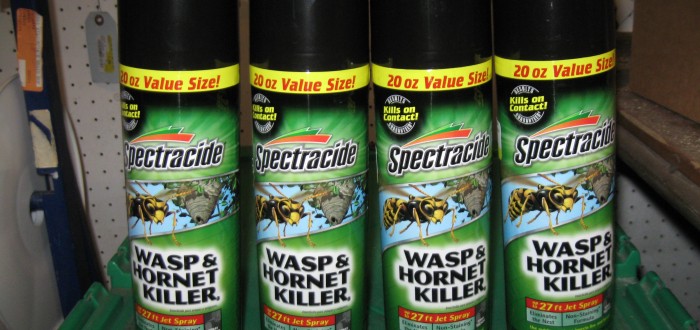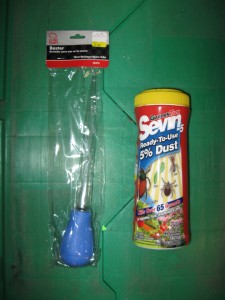I can always tell when the seasons are passing by the products that we sell here at Hill Hardware. Especially pest control products. Pests seem to come out in waves and it seems to be more dependent on the weather than anything else. “Late Summer” seems to be defined by the appearance of hordes of yellow jackets, wasps and hornets, and I can tell when it is here because the wasp spray seems to just fly off the shelf.
First a little information. Lots of people come in the store and ask for “bee spray”. While these products do work on honey bees, usually folks are not actually spraying bees. Honey bees are beneficial and usually are not aggressive towards people. The only time that lots of them congregate together is near the hive or when they are swarming looking for a new home. I just finished mowing by the hives in our field, and the bees just ignored me. When bees are swarming they can bee pretty scarey, but they usually won’t sting and you can actually call a local beekeeper and they will come and capture them for free. Check the “Good News” paper to find a number to call. We did this one time and I even helped. It was pretty exciting but nobody got stung.
Wasps, hornets and yellow jackets can be a different story. While they are also beneficial insects, they can cause trouble, especially if they have nested near where people pass, usually doorways or garages. There are several types of stinging insects around, but they fit in a few general categories. Yellow jackets usually nest either in holes in the ground, in spaces in the sides of buildings, or one type builds paper-type nests in trees and bushes or under the eaves of houses. Wasps usually have smaller, open nests inside sheds or under the eaves. Another type of wasp, mud daubers build nests of mud in a sheltered spot usually under shed roofs or under parked cars. “Paper” wasps and hornets are much larger and build huge nest balls up in trees or under shed eaves or even inside barns if they can find a place to fly in.
There are several ways of dealing with these bad guys depending on how they are nesting. Trying to spray individual insects can be futile, as there can be hundreds of them. If you can see the nest, the best way to get them is to wait until nighttime and then thoroughly hose down the nest with wasp spray. These cans are made to spray about 15 feet so you don’t have to get that close. Nighttime is best as all the baddies will be in the nest and they usually will not fly at night, so you’re fairly safe. Check the nest for the next few days and if there is no sign of life, you’re all set. If you see more bugs, repeat the spraying.
Yellow jackets that have nested in the ground or inside hollow house walls are more difficult to deal with. They make foaming spray that will fill up the hole leading to the nest, like shaving cream. But it can take several applications to get them all. Another way is to use insecticide dust. You have to get creative, though, to get it in the nest entrance. We have turkey basters that work pretty well, or the old fashioned battery fillers work also. The idea is to get as much of the dust into the nest opening as possible so the insects will have to go through it and will track it into the nest. Wall nests can be especially difficult as the actual nest can be several feet away from the entrance, up inside the wall cavity. Just don’t jump the gun and seal up the entrance until you are sure that they are all dead, because if they aren’t, they will find another way to get out, often into the house.
Good luck soldier, and be (bee!) careful out there.


